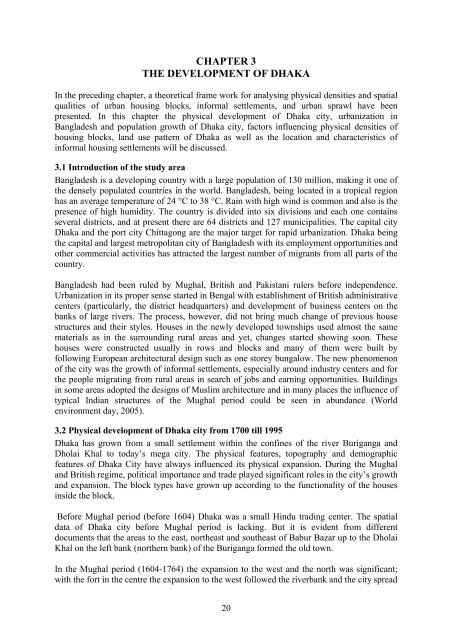Physical Density and Urban Sprawl: A Case of Dhaka City - KTH
Physical Density and Urban Sprawl: A Case of Dhaka City - KTH
Physical Density and Urban Sprawl: A Case of Dhaka City - KTH
You also want an ePaper? Increase the reach of your titles
YUMPU automatically turns print PDFs into web optimized ePapers that Google loves.
CHAPTER 3<br />
THE DEVELOPMENT OF DHAKA<br />
In the preceding chapter, a theoretical frame work for analysing physical densities <strong>and</strong> spatial<br />
qualities <strong>of</strong> urban housing blocks, informal settlements, <strong>and</strong> urban sprawl have been<br />
presented. In this chapter the physical development <strong>of</strong> <strong>Dhaka</strong> city, urbanization in<br />
Bangladesh <strong>and</strong> population growth <strong>of</strong> <strong>Dhaka</strong> city, factors influencing physical densities <strong>of</strong><br />
housing blocks, l<strong>and</strong> use pattern <strong>of</strong> <strong>Dhaka</strong> as well as the location <strong>and</strong> characteristics <strong>of</strong><br />
informal housing settlements will be discussed.<br />
3.1 Introduction <strong>of</strong> the study area<br />
Bangladesh is a developing country with a large population <strong>of</strong> 130 million, making it one <strong>of</strong><br />
the densely populated countries in the world. Bangladesh, being located in a tropical region<br />
has an average temperature <strong>of</strong> 24 °C to 38 °C. Rain with high wind is common <strong>and</strong> also is the<br />
presence <strong>of</strong> high humidity. The country is divided into six divisions <strong>and</strong> each one contains<br />
several districts, <strong>and</strong> at present there are 64 districts <strong>and</strong> 127 municipalities. The capital city<br />
<strong>Dhaka</strong> <strong>and</strong> the port city Chittagong are the major target for rapid urbanization. <strong>Dhaka</strong> being<br />
the capital <strong>and</strong> largest metropolitan city <strong>of</strong> Bangladesh with its employment opportunities <strong>and</strong><br />
other commercial activities has attracted the largest number <strong>of</strong> migrants from all parts <strong>of</strong> the<br />
country.<br />
Bangladesh had been ruled by Mughal, British <strong>and</strong> Pakistani rulers before independence.<br />
<strong>Urban</strong>ization in its proper sense started in Bengal with establishment <strong>of</strong> British administrative<br />
centers (particularly, the district headquarters) <strong>and</strong> development <strong>of</strong> business centers on the<br />
banks <strong>of</strong> large rivers. The process, however, did not bring much change <strong>of</strong> previous house<br />
structures <strong>and</strong> their styles. Houses in the newly developed townships used almost the same<br />
materials as in the surrounding rural areas <strong>and</strong> yet, changes started showing soon. These<br />
houses were constructed usually in rows <strong>and</strong> blocks <strong>and</strong> many <strong>of</strong> them were built by<br />
following European architectural design such as one storey bungalow. The new phenomenon<br />
<strong>of</strong> the city was the growth <strong>of</strong> informal settlements, especially around industry centers <strong>and</strong> for<br />
the people migrating from rural areas in search <strong>of</strong> jobs <strong>and</strong> earning opportunities. Buildings<br />
in some areas adopted the designs <strong>of</strong> Muslim architecture <strong>and</strong> in many places the influence <strong>of</strong><br />
typical Indian structures <strong>of</strong> the Mughal period could be seen in abundance (World<br />
environment day, 2005).<br />
3.2 <strong>Physical</strong> development <strong>of</strong> <strong>Dhaka</strong> city from 1700 till 1995<br />
<strong>Dhaka</strong> has grown from a small settlement within the confines <strong>of</strong> the river Buriganga <strong>and</strong><br />
Dholai Khal to today’s mega city. The physical features, topography <strong>and</strong> demographic<br />
features <strong>of</strong> <strong>Dhaka</strong> <strong>City</strong> have always influenced its physical expansion. During the Mughal<br />
<strong>and</strong> British regime, political importance <strong>and</strong> trade played significant roles in the city’s growth<br />
<strong>and</strong> expansion. The block types have grown up according to the functionality <strong>of</strong> the houses<br />
inside the block.<br />
Before Mughal period (before 1604) <strong>Dhaka</strong> was a small Hindu trading center. The spatial<br />
data <strong>of</strong> <strong>Dhaka</strong> city before Mughal period is lacking. But it is evident from different<br />
documents that the areas to the east, northeast <strong>and</strong> southeast <strong>of</strong> Babur Bazar up to the Dholai<br />
Khal on the left bank (northern bank) <strong>of</strong> the Buriganga formed the old town.<br />
In the Mughal period (1604-1764) the expansion to the west <strong>and</strong> the north was significant;<br />
with the fort in the centre the expansion to the west followed the riverbank <strong>and</strong> the city spread<br />
20

















